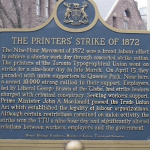By Ben Gross
As the Ministry of Education works to incorporate the Calls to Action of the Truth and Reconciliation Commission into curriculum updates, teachers around the province are following suit. We recognize the incredible significance of these Calls to Action, particularly in education, and are working hard to find ways to make our teaching or Canadian history more nuanced and more accurate. Since we start the Grade 10 Canadian History course in 1914 the establishment of the Indian Act, and the hundreds of years of history before that, is outside of our curriculum documents. However, I have found that it is difficult for students to wrap their heads around the Indian Residential Schools as one piece of a much larger system of violent assimilationist termination policies when the background information is missing. Our curriculum document is already packed with content, so the problem I set out to solve was “If we don’t have time, but this information is necessary for deeper understanding of systems of violence and oppression, not just instances, what can I create to accomplish this task in a very short time period?”
The lesson that I came up with was part of a workshop sponsored by Facing History and Ourselves at the OHASSTA conference in Ottawa last November. Here is what it looked like:
1. I selected a series of excerpts from the “History” section of Facing History and Ourselves’ resource guide on the Indian Residential Schools, Stolen Lives: The Indigenous Peoples of Canada and the Indian Residential Schools. These excerpts address the time period between 1683 and the early 1900s.
2. Each of these quotes was taped to a piece of chart paper in preparation for a Big Paper activity.
3. The central guiding question for this activity was: How did European Settlers view Indigenous Peoples?This was complemented with prompts such as:
- What connections do you make to previous knowledge?
- What questions do you have about content or ideas?
- How do you feel about what you are reading?
4. Students (teachers in this case!) completed the Big Paper activity in their initial groups then did a Gallery Walk of the other readings, using sticky notes to respond to each others’ ideas and questions.
5. At the end of this process each group had a few minutes to debrief verbally before we spoke as a whole class.
6. We discuss any questions or comments that students have about the readings to help consolidate and clarify meanings and ideas.
7. On chart paper (or a blackboard or whiteboard) we listed all of the terms and ideas that informed us about the way that European Settlers viewed Indigenous Peoples. Words that come up often are savage, obstacle, useless, heathen, uncivilized, to list a few.
8. This list becomes part of our framework for understanding the long history Settler ideas about Indigenous Peoples and gives us a place to start in terms of understanding the drive behind Indian Residential Schools and famous lines such as “Kill the Indian in the Child.”
This lesson has worked very well in a variety of courses to help give some historical context and to frame coming discussions about Indian Residential Schools and the Sixties Scoop. These views and ideas, unfortunately, remain relevant even today as students will make connections to words from the chart such as “obstacles” and bring up historical events such as the Oka Crisis or contemporary events such as the Site C Dam or pipelines. This is but one way to approach this challenge in courses such as Grade 10 Canadian History.
Ben Gross is ACL of Social and Global Studies at Don Mills CI in Toronto District School Board.


